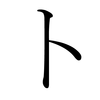- To (kana)
-

Hiragana
KatakanaTransliteration: to Hiragana Man'yōgana: 止 Katakana Man'yōgana: 止 kana gojūon n wa ra ya ma ha na ta sa ka a sokuon wi ri mi hi ni chi shi ki i dakuten ru yu mu fu nu tsu su ku u chōonpu we re me he ne te se ke e wo ro yo mo ho no to so ko o と, in hiragana, or ト in katakana, is one of the Japanese kana, each of which represents one mora. Both represent the sound [to], and when written with dakuten represent the sound [do]. In the Ainu language, the katakana ト can be written with a handakuten (which can be entered in a computer as either one character (ト゚) or two combined characters (ト゜)) to represent the sound [tu], and is interchangeable with the katakana ツ゚.
Form Rōmaji Hiragana Katakana Normal t-
(た行 ta-gyō)to と ト tou
too
tō, tohとう, (とぅ)
とお, とぉ
とートウ, (トゥ)
トオ, トォ
トーAddition dakuten d-
(だ行 da-gyō)do ど ド dou
doo
dō, dohどう, (どぅ)
どお, どぉ
どードウ, (ドゥ)
ドオ, ドォ
ドーOther additional forms Form A (tw-) Romaji Hiragana Katakana twa とぁ トァ twi とぃ トィ tu, twu とぅ トゥ twe とぇ トェ (two) (とぉ) (トォ) Form B (dw-) Romaji Hiragana Katakana dwa どぁ ドァ dwi どぃ ドィ du, dwu どぅ ドゥ dwe どぇ ドェ (dwo) (どぉ) (ドォ) Stroke order
Categories:- Specific kana
- Writing system stubs
Wikimedia Foundation. 2010.


